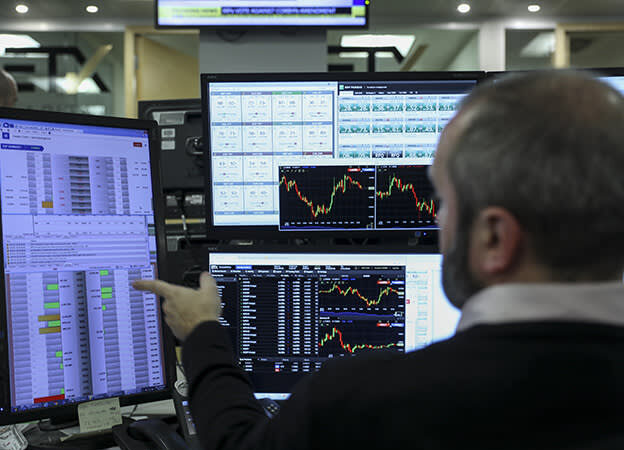
- Flows into European bond ETFs slowed down between July and September
- Investors were bullish on stocks, but were not rewarded for it
- Emerging markets and thematic ETFs had a difficult quarter
Earlier this year, the artificial intelligence boom brought a wave of optimism to the stock markets, with investors rushing back into US stocks after a tumultuous 2022. But the AI rally was mostly confined to the so-called ‘magnificent seven’ tech stocks while the rest trailed behind. The economic environment did not fully justify the bullishness when it came to other businesses. By August, some of the enthusiasm had gone and stocks had lost a portion of their previous gains. However, ETF investors maintained a degree of optimism towards the asset class in the third quarter and slowed their rush to bonds instead, according to data from Morningstar.
Inflows into European ETFs totalled €29.7bn (£25.9bn) between July and September, a small increase on the previous quarter’s €27.9bn but still well below the €38.9bn registered in the first three months of the year. Since 2019, European ETFs have seen positive flows over the vast majority of quarters, with the first three months of 2020 and the third quarter of 2022 the only exceptions. In the first quarter of 2021, flows peaked near the €50bn mark.
If overall flows were only slightly up between the second and the third quarter this year, their composition saw a shift. There was a marked increase in equity flows, which totalled €19bn against €12.6bn between April and June. Conversely, investors were more cautious on fixed income, with flows into bond ETFs dropping from €16bn in the second quarter to €12.2bn in the third quarter, as central banks pushed their new ‘higher for longer’ mantra on interest rates.
Jose Garcia-Zarate, associate director for passive strategies research at Morningstar, notes that neither stock or bond investors were rewarded for their bets. “The quarterly flows were almost fully offset by falls in stock and bond market valuations,” he says. “Most stock market indices closed the third quarter in negative terrain. Technology stocks, a key contributor to the rally in the first half of the year, led the decline.”
The majority of bond flows during the period were in July, while August and September were much slower. While less marked, a similar trend applied to stocks. “The monthly figures show the deterioration of investor sentiment through the period, particularly in fixed income, as the message of a sustained period of high interest rates sank in,” says Garcia-Zarate.
Stocks
Within stocks, the bulk of the flows went to US and global large-cap stocks with the iShares Core MSCI World ETF (IWDG) and the Invesco S&P 500 ETF (SPXP) the two most popular stock market ETFs over the period.
Interestingly, the third place was occupied by the Xtrackers S&P 500 Equal Weight ETF (XDWE). Equal weight ETFs make the same allocation to each company in the index regardless of its size, so they offer investors exposure to the US market without betting the farm on the tech giants. After the ‘magnificent seven’ drove US performance in the first half of the year, many have been hoping that the rally might broaden and reach other sectors, but this has yet to materialise.
UK large-cap stocks also had inflows, which totalled €370mn, as did Swiss equities (€840mn), Indian equities (€550mn) and the energy sector (€500mn). The flows into Swiss companies partly reversed the €1.1bn of outflows in the second quarter, when investors reacted to the demise of Credit Suisse.
Meanwhile, the financial services sector experienced the highest outflows within stocks of €1.1bn. “The fast rise in interest rates may have contributed to healthier results in the banking sector in the past year, but investors now seem to be more concerned about the negative effects of a sustained period of high rates on the demand for loans,” argues Garcia-Zarate. Investors also pulled money from Chinese and Asian equities over concerns about the Chinese economy.
Bonds
Bond ETF investors favoured government bonds. Euro and dollar government bonds were the most popular with inflows of €3.24bn and €3.20bn respectively, but sterling government bonds also did well at €1.91bn. The most popular ETFs for investing in UK government bonds were the iShares UK Gilts 0-5yr ETF (IGLS) and the iShares Core UK Gilts ETF (IGLT).
“Against a general backdrop of increased pessimism and reassessment of monetary policy expectations, investors again sought positioning toward the shorter end of the yield curve,” says Garcia-Zarate. “In fact, several of the top money-gathering bond ETFs in the quarter were cashlike alternatives.”
Flows into money markets jumped over the course of the year, increasing from €130mn in the first quarter to €880mn in the second and €2.16bn in the third. Longer-dated bonds continued to sell off in October, sending both US and UK 10-year yields up, so this trend might not be over yet as we wait to see whether interest rates have effectively peaked.
Meanwhile, “the mix of ongoing problems in China and the message of ‘high rates for longer’ is not doing any favours to emerging markets debt,” notes Garcia-Zarate. Global emerging markets local currency bonds had the most outflows within fixed income of €690mn, and investors also pulled money from their dollar-denominated counterparts.
During the quarter, iShares launched iBond ETFs, the first fixed maturity bond ETFs in Europe. These funds mature on a fixed date, just like their underlying portfolio of bonds, at which point they pay out their NAV to shareholders. This allows investors to build so-called “bond ladders”, a strategy that involves buying bonds with equally spaced maturity dates in order to reduce interest rate risk, by buying ETFs rather than individual bonds directly.
European investors also continued to divest from commodities, which experienced their second quarter of outflows in a row. This was led by precious metals exchange-traded commodities (ETCs), which make up the vast majority of assets under management in the space, with investors pulling money from gold ETFs in particular.
Investors also pulled €100mn from thematic ETFs over the quarter, reversing some of the gains made by the sector in Q2. Thematic ETFs enjoyed a bout of popularity between the end of 2020 and 2021, but investors have been much more cautious on them since then. In September, Cathie Wood’s Ark Invest bought Rize ETF, a fund known for thematic offerings. The deal will also give European investors access to Ark’s funds.
Finally, ETFs with an environmental, social and governance (ESG) tilt had a lukewarm quarter. Investors poured €7.2bn into them, but this was down from €10.6bn in the second quarter and one of the worst three-month periods since the beginning of 2020.







